Dates for your Diary
Closed until further notice.
Museum opening times
Closed until further notice.
100 Club
Suspended until museum re-opens.
Spring Will Come Again
While we accept these times are difficult
There does exist in some needless negativity
While we are in a crisis situation now
And hard winter is biting
We must not cry too much
Spring will come again
Look for the brightness, cast away the sadness
And let bright hope triumph over darkness
Spring will come again.
Thanks to reader Susan Davies, who wrote this short piece to remind us better times are ahead.
The Abertillery Kid
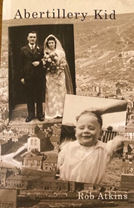 Published by Amazon in August 2020, this book found its way into my Christmas stocking! It’s written by Robert Atkins, who grew up in Abertillery but now lives in Raglan. Being the same age, Rob and I attended the same schools and I was able to put a face to many of the people mentioned. The museum too gets a mention and his mother-in-law, Margaret Phillips, is a long-standing museum supporter and volunteer. Robert may no longer live in Abertillery, but his love for the town shines through in his book. Anyone interested in reading The Abertillery Kid can purchase a copy from Amazon, and it is also available as a digital download from Kindle.
Published by Amazon in August 2020, this book found its way into my Christmas stocking! It’s written by Robert Atkins, who grew up in Abertillery but now lives in Raglan. Being the same age, Rob and I attended the same schools and I was able to put a face to many of the people mentioned. The museum too gets a mention and his mother-in-law, Margaret Phillips, is a long-standing museum supporter and volunteer. Robert may no longer live in Abertillery, but his love for the town shines through in his book. Anyone interested in reading The Abertillery Kid can purchase a copy from Amazon, and it is also available as a digital download from Kindle.
Transporter Bridge Update
In the May 2020 edition of this newsletter, I reported on a planned new visitor centre for Newport Transporter Bridge, well I’m pleased to say that a recent BBC news report has confirmed that £8.75m has been secured from the National Lottery Heritage Fund. The fund will be used for repairs and the new visitor centre which will include a café, shop, toilets and an exhibition gallery. It is hoped the new centre will double the number of visitors the bridge currently attracts.
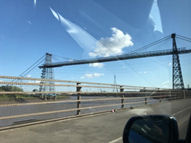
There are more photos of this bridge, including some from the top, on the Museum’s Facebook page.
A letter from Marie Hobson in NSW
Dear Members of Abertillery Museum,
Sending our very best wishes for a much improved year for everyone in the UK now that the Vaccine is being rolled out across the country. We are praying for good health and safety for all of your members.
In Australia we have been very lucky, but still far too many people have died with the virus spreading after people cheated the lockdown and spread the virus. We thought we were home and dry after the state borders had re-opened but one airline employee, who had been to America, carried it to the North Shore of Sydney and then it arrived in Melbourne again. These cities are facing serious restrictions again… even the Boxing Day Sydney to Hobart Yacht race was cancelled for the first time in its 72 year history.
We have been relatively unscathed here in country New South Wales and visitors are arriving in droves in caravans, everyone has been very good about correct check-in and hand disinfectant etc at our museum so we are hoping it will continue. It is the same all around town.
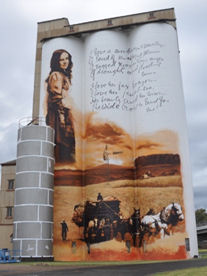 Before Christmas an artist from Melbourne came to Gunnedah and painted an amazing art work on our maize mill silo (40’ high). The mural is of Australian poet Dorothea Mackellar who wrote the iconic poem My Country. Her family migrated from England but she was born here and when they went back to visit, she always became homesick for Australia. The poem, which established Dorothea as a poet, epitomises everything that Australia is: “a wilful lavish land, all you who have not loved her, you will not understand.”
Before Christmas an artist from Melbourne came to Gunnedah and painted an amazing art work on our maize mill silo (40’ high). The mural is of Australian poet Dorothea Mackellar who wrote the iconic poem My Country. Her family migrated from England but she was born here and when they went back to visit, she always became homesick for Australia. The poem, which established Dorothea as a poet, epitomises everything that Australia is: “a wilful lavish land, all you who have not loved her, you will not understand.”
Dorothea’s family owned two large properties north of the Namoi River at Gunnedah, and she spent a great deal of time there. Her father and brothers were great philanthropists, contributing enormously to the town. The Dorothea Mackellar poetry competition for schools is based here in Gunnedah.
In the past few months, we have also seen the breaking of the drought which has plagued our countryside for five years. The dams are full again, the river is running and the countryside is a picture of green. Many of our farmers struggled to stay afloat and it is wonderful to see them smiling again.
Our town also has a new independent newspaper, launched in November by the owners of the local paper in a neighbouring town. Sadly our paper, which had been independent for 125 years, was gobbled up by a large corporation and slowly diminished from “best bi-weekly in NSW” to a miserable little online version once a week. It was a giant leap of faith for Narrabri owners who are very committed to our town… I was so passionate about having a newspaper again that I put my hand up to go back to work as a journalist at the age of 71… it is in my blood! As you know, hard copy newspapers are essential for historical societies.
My family gathered for Christmas, 11 children and 10 adults and it was wonderful to have them home. We were also blessed with cool showery weather, a stark contrast to last Christmas when it was 40 degrees.
I will leave you with the words of Dorothea’s My Country and attach some images of the mural which sits alongside our Vietnam War murals on our museum. It is a great tourist attraction. Your members may like to have a look at the Australian Silo Art Trail on Facebook.. some amazing work around the country. The artist worked in a boom lift, the week he started it was almost 40 degrees here so he could only work when the sun moved around the back.
Warm regards from Australia, Marie.
Many thanks to Marie Hobson for her lovely letter and you can read the poem she sent down below. Marie also sent several photos of things mentioned here including the Keepit Dam and the Namoi River and also of Gunnedah looking green and lush again but unfortunately space does not permit me to include them here however they are available to view on Abertillery Museum’s Facebook page.
I vote we ‘twin’ with Gunnedah Museum and bags I first in the queue for an exchange visit!
My Country
The love of field and coppice
Of green and shaded lanes,
Of ordered woods and gardens
Is running in your veins.
Strong love of grey-blue distance,
Brown streams and soft, dim skies
I know, but cannot share it,
My love is otherwise.
I love a sunburnt country,
A land of sweeping plains,
Of ragged mountain ranges,
Of droughts and flooding rains.
I love her far horizons,
I love her jewel-sea,
Her beauty and her terror
The wide brown land for me!
The stark white ring-barked forests,
All tragic to the moon,
The sapphire-misted mountains,
The hot gold hush of noon,
Green tangle of the brushes
Where lithe lianas coil,
And orchids deck the tree-tops,
And ferns the warm dark soil.
Core of my heart, my country!
Her pitiless blue sky,
When, sick at heart, around us
We see the cattle die
But then the grey clouds gather,
And we can bless again
The drumming of an army,
The steady soaking rain.
Core of my heart, my country!
Land of the rainbow gold,
For flood and fire and famine
She pays us back threefold.
Over the thirsty paddocks,
Watch, after many days,
The filmy veil of greenness
That thickens as we gaze ...
An opal-hearted country,
A wilful, lavish land
All you who have not loved her,
You will not understand
though Earth holds many splendours,
Wherever I may die,
I know to what brown country
My homing thoughts will fly.
Dorothea Mackellar (1865 – 1968)
Coal News October 1980
I reported In January that museum member, Vera Smith, sadly passed away in December. Her son Ian, when going through her belongings recently, came across a newspaper clipping from ‘Coal News’. The carefully preserved clipping, is dated October 1980 and concerns Vera’s husband Harry and his brother Don (both now deceased).

The newspaper clipping from 1980 – right Harry and Don Smith
Brother’s unique link with pit’s past…
Pitmen brothers, Harry and Don Smith, can bet their pit boots on claiming a unique family record at a 90-year-old Gwent colliery.
Storeman Don, aged 54, and Harry, 57, who works in the pit power house, are carrying on a mining tradition which stretches back nearly 100 years. They are the third generation of a family of pitfolk who moved into the Abertillery area during the industrial revolution.
Their grandfather, John smith, was the first link in the story when he moved to South Wales from Yorkshire just before Six Bells Colliery was sunk in 1890. He was the first overman at the pit and had earlier helped a team of shaft sinkers at the colliery.
His two sons, repairer Bill – Don and Harry’s father – and John Smith forged the next pit connection by each putting in over 40 years.
Don and Harry followed their father’s footsteps and joined Six Bells when they left school.
Says Harry: “I was 14 when I started back in 1937 and since I was 18 I can claim to have worked seven days a week in the colliery power house. At one time the pit was generating electricity for the valley when there were only limited supplies from power stations.”
End of an Era
And Don adds: “Mining has been in our blood all our lives – but now we are the last link in the chain and when we retire three generations of a mining family at Six Bells will finally come to an end.”
Says Six Bells NUM lodge treasurer Brian Phelps: “Altogether, the family has put in some sterling service and the lads here feel that Don and Harry must have set a unique family record among our 638 workforce.”
Many thanks to Ian for sharing this with us.
The Sewing Machine
My sewing machine is a much treasured possession that I would never want to be without and while it is mostly used for alterations these days, in 2020 it was most used for the making of face masks! Think of a sewing machine manufacturer and instantly ‘Singer’ comes to mind, but surprisingly, Singer was not the first to produce a sewing machine…
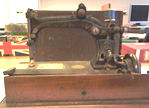 Left: The museum’s 1878 ‘Wheeler & Wilson’ machine.
Left: The museum’s 1878 ‘Wheeler & Wilson’ machine.
The very earliest sewing machine is thought to have been invented by a Londoner, Thomas Saint, who deposited his design with the London Patent office in 1790 though it is not known if he ever built a working model. Many attempts were made to create the first successful sewing machine and probably the most important breakthrough came in 1807 by Edward Chapman with the development of a needle that had the eye at the pointed end as is still the case today. This breakthrough allowed for a continuous supply of thread, vital for a sewing machine. The first successful sewing machine was made by Bartholemy Thimmonier who was a French tailor. Eighty of his machines were used in a Paris shop and were used to make army uniforms. However other Paris tailors, worried that their livelihoods were being threatened, broke into the shop and smashed all the machines.
These early machines were chain-stitch machines using only one (upper) thread and usually a curved needle. The modern machines we know today owe their design to a great many innovators such as American Walter Hunt who, in 1834, invented the lock-stitch machine which used two interlocking threads, the lower from a bobbin and shuttle, which is still the case today. Other contributors’ included American Elias Howe who patented his lock-stitch machine in 1846 and Blodgett and Lerow who patented the ‘Rotary’ sewing machine in 1849. This latter machine came to the attention of one Issac Singer who in 1851, took the design and improved on it adding a perpendicular needle, a presser foot to hold the fabric in place, a feed to help the material pass through the machine and a treadle.
So far all these hand or foot operated machines were only intended for industrial use (the electric machine was still 50 years away). The first domestic sewing machine was produced by Singer in 1858 which is probably why, when we think of a home sewing machine, the first name that comes to mind is Singer. In the 1890s Singer introduced his machines into English schools and so sewing lessons began (school girls being potential future customers). But Singer was not the only machine manufacturer around at this time. Allen B Wilson teamed up with Nathaniel Wheeler and the subsequent ‘Wheeler & Wilson’ Company went on to be the biggest manufacturer of sewing machines in America in the second half of the 1800s and the museum is lucky to have one of these early machines. The company was later bought out by Singer.
Left: The museum’s 1878 ‘Wheeler & Wilson’ machine
My interest in sewing began in junior school. I started by making dolls clothes by hand but this was tedious so I pleaded for a machine. My parents took me to the Singer Sewing shop in Newport and bought me an old (Singer) hand machine for £19 and from then I quickly moved on to making my own clothes from ‘Butterick’ paper patterns (founded 1863 and now owned by McCall). My machine had an elongated bobbin and shuttle (the fore-runner of the round bobbin) and it was a nightmare to get the thread to ‘catch’ in the shuttle. I lived in dread of changing thread colour or it running out! Then when I was 13 my parents bought me an electric sewing machine, a ‘New Home’ by Janome. It cost £37 from John Lewis in Bristol which was very cheap when compared to an equivalent Singer which would have set my parents back £70 plus. I loved that machine with its zigzag stitch, reverse sewing, automatic buttonhole feature (none of which my old machine was capable of) and, most importantly for me, an easy to use round bobbin and shuttle! It even folded away in its own table though this was a later addition.
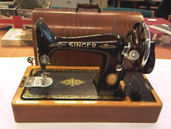 I had that machine until 2004 when, after over 30 years, it finally seized up. It was replaced with another ‘Janome’ and apart from the addition of an automatic needle threader (which I find invaluable with my eyesight the way it is now), everything else was exactly the same. Thirty years on I had expected the bobbin and shuttle to have changed again but no, it was as if time had stood still. Nice to know some things never change!
I had that machine until 2004 when, after over 30 years, it finally seized up. It was replaced with another ‘Janome’ and apart from the addition of an automatic needle threader (which I find invaluable with my eyesight the way it is now), everything else was exactly the same. Thirty years on I had expected the bobbin and shuttle to have changed again but no, it was as if time had stood still. Nice to know some things never change!
Sally Murphy
For more photos of the Museum’s sewing machines, including a child’s miniature one, visit our Facebook page.
Top Of Page
